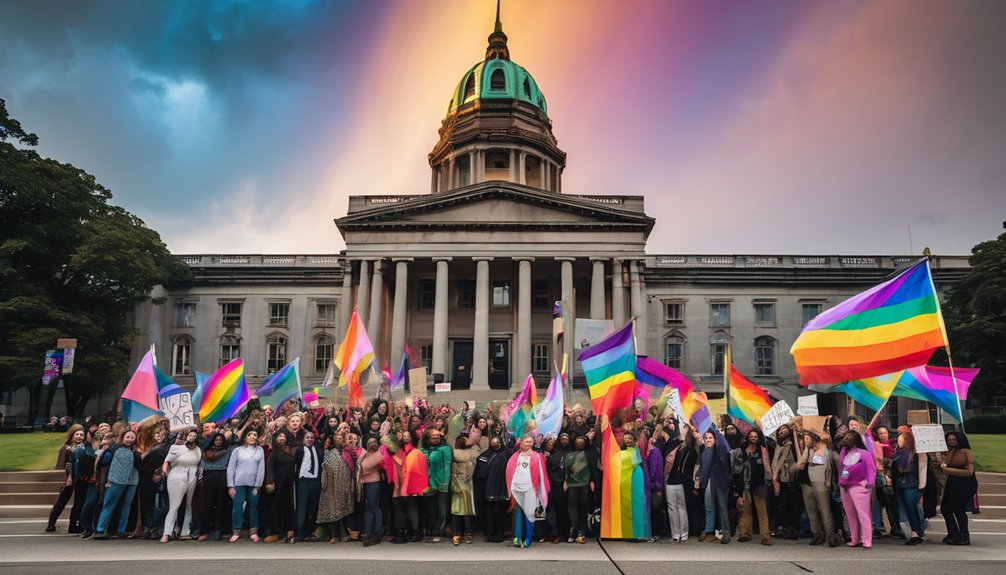Under Siege: The Escalating War on Transgender Rights


Table of Contents
ToggleTransgender rights are facing unprecedented challenges as systematic discrimination resurfaces across multiple sectors. Policies like Project 2025 aim to strip away hard-won protections, impacting healthcare access and educational environments. Amidst escalating violence against transgender individuals, some states, such as California, stand firm in defense of these rights. What implications do these developments hold for the future, and how can individuals and communities respond effectively to this growing crisis?
As societies evolve, it’s important to recognize the rich tapestry of transgender identities throughout history. Diverse cultures, including Native American communities, have acknowledged transgender individuals, such as the Two-Spirit people, who held significant spiritual roles. The modern fight for transgender rights surged during the Stonewall Riots in 1969, highlighting the crucial role of transgender women of color in LGBTQ activism. A landmark moment occurred in 2020 when the Supreme Court ruled in Bostock v. Clayton County, affirming that firing someone for being transgender constitutes discrimination under the Civil Rights Act. The Obama administration’s 2016 guidance established critical federal protections for transgender students, allowing them to use bathrooms that align with their gender identity, showcasing a historical legacy of recognition and rights amidst ongoing challenges.

While progress has been made in the fight for transgender rights, the reality is that systematic discrimination remains pervasive and deeply rooted in multiple institutions. Transgender service members face unjust barriers, like being denied retirement benefits, forcing them into tough decisions about their careers. The alarming rise in anti-transgender bills reflects a broader societal trend, with over 930 recorded incidents of violence against the transgender community in just one year. This climate of fear extends to advocates, as seen with threats against Minnesota State Representative Leigh Finke. Moreover, the tragic murder of Sam Nordquist underscores the deadly consequences of anti-transgender hatred. For transgender youth, supportive environments and access to health care are vital, yet discrimination continues to erode these fundamental legal protections.

Systematic discrimination against transgender individuals has reached a critical phase with the introduction of Project 2025, a proposal from the Heritage Foundation that seeks to erase sexual orientation and gender identity from federal recognition. This initiative threatens vital transgender rights, including the removal of Medicare and Medicaid coverage for gender-affirming medical care. It also imposes educational restrictions that require parental permission for using a student’s preferred name or pronouns, undermining their identity. Furthermore, Project 2025 aims to ban transgender individuals from military service, reversing recent inclusivity advancements. The plan’s broader agenda targets anti-LGBTQ+ policies, potentially allowing employers to discriminate based on personal beliefs, thereby eroding existing protections for transgender people.
California stands out as a guiding light of protection for transgender rights, implementing laws that not only guarantee all-encompassing insurance coverage for gender-affirming care but also affirm the rights of transgender students to access facilities that align with their gender identity. The state mandates schools support these students, fostering an inclusive environment free from discrimination. Furthermore, California’s employment protections surpass federal standards, ensuring equal protection by prohibiting discrimination based on gender identity and expression. In addition, streamlined processes for legal name changes and gender marker updates make it easier for individuals to affirm their identities legally. As anti-trans legislation rises nationally, California serves as a model, actively promoting policies that safeguard the rights and dignity of transgender individuals.
In the face of rising anti-trans legislation, understanding your rights and knowing how to take action is more vital than ever. Here are some key steps you can take to advocate for transgender rights:
Many people mistakenly believe transgender individuals are simply confused about their gender identity. Take Alex, who faced employment discrimination despite their qualifications. Misconceptions like this stem from stereotypes perpetuated by media representation. You might think pronoun usage is trivial, but it’s crucial for social acceptance and legal recognition. Moreover, understanding historical context can illuminate issues like healthcare access and educational inclusion, revealing the systemic barriers many transgender people face in society.
You can support transgender rights effectively by engaging in solidarity actions and using inclusive language in your daily interactions. Participate in advocacy strategies that promote education initiatives and allyship training to build understanding. Prioritize community engagement through visibility campaigns that uplift transgender voices. Support policy reform that protects rights and access to mental health resources. Lastly, cultivate intersectional awareness, recognizing the diverse experiences within the transgender community to improve your allyship.
Misinformation greatly shapes public attitudes towards transgender people. It fuels stereotype reinforcement and social stigma, often driven by political rhetoric and media influence. When you encounter false narratives, it can skew public perception, making it harder for individuals to empathize with the transgender community. To counter this, awareness campaigns, education initiatives, and effective advocacy strategies are essential. They help build understanding and challenge harmful misconceptions, fostering a more supportive environment for transgender rights.
It’s ironic how laws meant to protect can actually hinder mental health in the transgender community. Anti-trans bills create access barriers to necessary healthcare, exacerbating societal stigma and discrimination effects. Without identity validation, you might feel isolated, struggling to develop coping strategies. Legislative impact can diminish emotional resilience, while community support becomes essential. The resulting healthcare disparities only deepen the mental health crisis, highlighting the urgent need for understanding and compassion.
If you’re facing discrimination, several resources can help you navigate these challenges. Legal aid organizations can assist with understanding your rights. Support groups and community networks provide emotional support and shared experiences. Advocacy organizations work to protect your employment rights and housing assistance. Mental health resources are essential for your well-being. For educational resources, consider online forums that discuss healthcare access and legal matters relevant to your situation.
As the struggle for transgender rights intensifies, you must recognize the intersections of history, policy, and personal experience. The current crisis isn’t just a distant issue; it touches lives daily. Project 2025 reveals the urgent need for vigilance, while California stands as a demonstration of what protection looks like. You have the power to take action—educate yourself, advocate for change, and support those in need. Together, we can combat discrimination and build a more inclusive future.
 Activism and ChangeOctober 26, 2025What Is the Social Conflict Theory of Transgender People?
Activism and ChangeOctober 26, 2025What Is the Social Conflict Theory of Transgender People? Activism and ChangeOctober 25, 2025Fleeing the USA: The Reality Behind Transgender Americans’ Search for Safety
Activism and ChangeOctober 25, 2025Fleeing the USA: The Reality Behind Transgender Americans’ Search for Safety Fashion and ExpressionOctober 25, 2025First Time With Lip Filler? Here’s What to Expect
Fashion and ExpressionOctober 25, 2025First Time With Lip Filler? Here’s What to Expect Featured PostsOctober 24, 2025After Facial Feminization Surgery: A Guide to Recovery and Beyond
Featured PostsOctober 24, 2025After Facial Feminization Surgery: A Guide to Recovery and Beyond